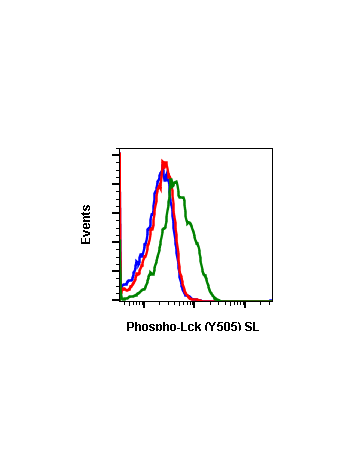Phospho-Lck (Tyr505) (A3) rabbit mAb
From
$210.00
In stock
Only %1 left
SKU
2301
Lck is a member of the Src family of non-receptor tyrosine kinases and plays a major role in T cell activation. Lck activates many downstream signaling pathways including Akt/mTOR, SAPK/JNK, PLCγ1, and RAS/MAPK. Phosphorylation of Lck at Tyr394 in the catalytic domain at the ATP-binding site stabilizes the open and active form, while phosphorylation at Tyr505 in the C-terminal domain promotes the closed, inactive conformation. Multiple small-molecule drugs used to treat leukemia have been shown to target inhibition of Lck, including imatinib and dasatinib. Lck is thus a promising target for suppressing T-cell responses for the treatment of inflammatory diseases or after organ transplantation.
| Applications | Flow Cytometry, WB |
|---|---|
| Clone | LckY505-A3 |
| Format | Unconjugated |
| Validated Reactivity | Human |
| Cross Reactivity | Predicted to work with mouse, rat and other homologues. |
| Detection | Anti-Rabbit IgG |
| Clonality | Monoclonal |
| Immunogen | A synthetic phospho-peptide corresponding to residues surrounding Tyr505 of human phospho Lck |
| Formulation | 1X PBS, 0.02% NaN3, 50% Glycerol, 0.1% BSA |
| Isotype | Rabbit IgGk |
| Preparation | Protein A+G |
| Recommended Usage | 1µg/mL – 0.001µg/mL. It is recommended that the reagent be titrated for optimal performance for each application. See product image legends for additional information. |
| Storage | -20ºC |
| Pseudonyms | Tyrosine-protein kinase Lck, Leukocyte C-terminal Src kinase, LSK, Protein YT16, T cell-specific protein-tyrosine kinase |
| Uniprot ID | P06239 |
| References | Serafin V, Capuzzo G, Milani G, et al. (2017) Blood. 130: 2750-2761. Lee KC, Ouwehand I, Giannini AL, et al. (2010) Leukemia. 24: 896-900. |
Write Your Own Review




